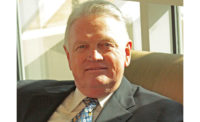Aerial daredevil Nik Wallenda took just 25 minutes to walk across a 2-in.-thick high wire strung 200 ft above Niagara Falls in June 2012, but the event required months of innovative planning. High-voltage transmission line engineer Peter Catchpole of POWER Engineers, Hailey, Idaho, was the visionary behind the high-tech tightrope that made the stunt possible.
“One of the things that attracted me to Peter when he first showed up in my office was [the realization] that he was probably one of the most innovative engineers I’ve ever been around,” says Ron Carrington, project director in the power delivery project management group at POWER Engineers. Carrington, who has worked with Catchpole for nearly 20 years, says the engineer, now retired at age 68, brings a creative approach to solving problems. “You think, ‘Gee, why didn’t I think of that?’ when he explains his solution,” Carrington says.
For the 1,800-ft-long Niagara Falls walk, POWER Engineers installed micropile anchors into bedrock to tension the cable at 30 tons by lifting both anchors with 170-ton cranes. Catchpole’s team also installed stabilizing pendulums to eliminate cable twisting, which would have made it unwalkable.
A year later, Wallenda walked across the Grand Canyon at the Little Colorado River Gorge on a 2-in.-thick cable designed by Catchpole. Wallenda made the 1,400-ft-long walk without a net or a safety harness.
Keen Observation, Passion
In nominating Catchpole for ENR’s Legacy Award, POWER CEO Bret Moffett writes: “Peter isn’t your ordinary engineer. He is the engineer you call when you have a challenge that goes beyond the ordinary. Transmission projects are his passion, and his solutions are creative, reliable and highly successful, just what you’d expect from an industry trailblazer.”
Born and raised in Ontario, Catchpole is a keen observer of the world, and that trait helps in engineering, Carrington says. “He’s able to observe the environment and the situation his engineering problem has been placed within and tailor solutions that fit that environment.” Carrington also links Catchpole’s engineering success to some of his hobbies—writing poetry and songs (he’s recorded more than 20 musical pieces) and building wooden boats in his garage.
From 2007-2009 Catchpole directed installation of the world’s second high-voltage transmission line catenary structure, located in the remote coastal mountains of British Columbia. The catenary stretches 4,000 ft across a valley, 500 ft above ground, and anchors to the mountains on either side, eliminating the need for structures on the avalanche-prone slopes below. Ironically, the designer of the original catenary in the 1950s, Canadian engineer Brian White, was Catchpole’s career mentor and a lifelong friend.
Catchpole’s familiarity with the transmission line dates back to the mid-1990s, when he was called in to consult on improvements for the line, explains John Rilkoff, transmission project director for Rokstad Power, British Columbia. Rilkoff worked with Catchpole on the catenary project as the owner’s rep for Rio Tinto Alcan.
Catchpole recalls seeing a picture of the original transmission line when he was about 7. He says the image sparked his passion for what would become a career in transmission design. “The power lines were covered in snow; it was awesome. And 40 years later, I was standing at that spot [to work on it]. Wow.”
Industry Connections
Catchpole’s colleagues say he understands the engineering-construction relationship. “When he’s designing, he is conscious of the contractor that has to build it, and he looks for input on what makes something more constructible,” Rilkoff says.
“It has been a very good ride,” Catchpole says, reflecting on a career that grew from what he calls “old-school electrical utilities” projects to “mentoring up-and-coming engineers and watching them grow,” then ultimately being asked to lead line failure investigations for POWER.
Catchpole’s investigations have led to design improvements that prevented failures from occurring. “Oftentimes he’s discovered a hidden defect exposed only when an extreme weather event such as a tornado or an ice or wind storm has hit a transmission line and the towers have failed,” Carrington explains.
Earlier in his career, Catchpole held various positions at Ontario Hydro (now Hydro One) and Great Lakes Power and was responsible for transmission line and substation projects and standards development. He owned his own engineering design company for three years before moving to the U.S. to join POWER in 1992.
Mentoring
Although Catchpole retired from POWER in 2015, he continues to help with various projects at the company on an ad hoc basis. “I’m technically still temporarily employed; I go in when the young people ask me to and work an hour or two every week. It’s a bit entertaining and nice to stay in touch,” he says.
Catchpole also was instrumental in developing and organizing POWER Engineers’ annual Power Delivery Design Conference in Sun Valley, Idaho, which attracts utility participants from the U.S., Canada and around the world.
Toward the end of his 45-year engineering career, Catchpole spent several years writing the book “Structural Engineering of Transmission Lines,” published in 2014. “It’s a textbook for transmission line engineers focused on the why and who of things more than the how,” he says. “How I look at every issue is in the book. Now I can walk away from the industry putting the period at the end of a sentence.”






Post a comment to this article
Report Abusive Comment